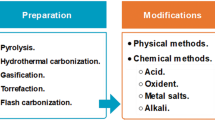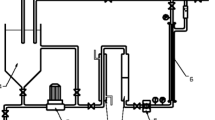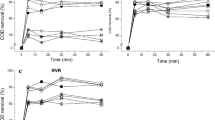Abstract
The feasibility of using recycled granular tire rubber (GTR) to remove molinate from contaminated water bodies was evaluated in this study. Adsorption equilibrium data was well described by a linear isotherm, and the adsorption was completely reversible. Breakthrough curves showed column efficiencies of approximately 40%, based on total capacity, and complete bed regeneration was achieved using clean water. The effluent from the regeneration step was successfully decontaminated using a defined bacterial mixed culture, capable of molinate mineralization. It was shown that this treated water can be used for regenerating a subsequently saturated bed. The GTR adsorbent showed two important features: complete reversibility towards molinate adsorption and stability along successive adsorption/bio-regeneration cycles. Common adsorbents, such as activated carbons and resins, loose performance very quickly under the same conditions, due to irreversible adsorption.








Similar content being viewed by others
Abbreviations
- BV:
-
Number of bed volumes, \( {\text{BV}} = tQ/V_{\text{b}} \)
- C :
-
Concentration of molinate in the liquid phase (mg dm−3)
- C 0 :
-
Concentration of molinate in the column inlet stream (mg dm−3)
- C eq :
-
Molinate concentration in the liquid phase, in equilibrium with a concentration q eq of molinate in the adsorbed phase (mg g−1)
- L b :
-
Bed length (cm)
- m ads :
-
Mass of adsorbent in the bed (g)
- Q :
-
Flow rate (cm3 s−1)
- q :
-
Molinate adsorbed concentration (mg g−1)
- q 0 :
-
Molinate adsorbed concentration, in equilibrium with a concentration C 0 of molinate in the liquid phase (mg g−1)
- q bt :
-
Bed capacity at breakthrough (mg g−1)
- q bed :
-
Total bed capacity based on breakthrough data (mg g−1)
- q eq :
-
Molinate adsorbed concentration, in equilibrium with a concentration C eq of molinate in the liquid phase (mg g−1)
- q isot :
-
Total bed capacity based on adsorption equilibrium data (mg g−1)
- S :
-
Column cross-section (cm2)
- t :
-
Time (s)
- t bt :
-
Breakthrough time (h)
- V b :
-
Bed volume (cm3)
- HPLC:
-
High performance liquid chromatography
References
Aktas, O., & Çençen, F. (2007). Bioregeneration of activated carbon: a review. International Biodeterioration & Biodegradation, 59, 257–272.
Alam, J. B., Dikshit, A. K., & Bandyopadhyay, M. (2000). Efficacy of adsorbents for 2,4-D and atrazine removal from water environment. Global NEST. International Journal, 2, 139–148.
Alam, J. B., Dikshit, A. K., & Bandyopadhyay, M. (2002). Effect of different inorganic and organic compounds on sorption of 2,4-D and atrazine. Journal of Environmental Science and Health Part B, 37, 541–560.
Alam, J. B., Dikshit, A. K., & Bandyopadhyay, M. (2005). Evaluation of thermodynamic properties of sorption of 2,4-D and atrazine by tire granules. Separation and Purification Technology, 42, 85–90.
Albanis, T. A., Hela, D. G., Sakellarides, T. M., & Konstantinou, I. K. (1998). Monitoring of pesticide residues and their metabolites in surface and underground waters of Imathia (N. Greece) by means of solid-phase extraction disks and gas chromatography. Journal of Chromatography, 823, 59–71.
Barreiros, L., Nogales, B., Manaia, C. M., Silva-Ferreira, A. C., Pieper, D. H., Reis, M. A., et al. (2003). A novel pathway for mineralization of the thiocarbamate herbicide molinate by a defined bacterial mixed culture. Environmental Microbiology, 5, 944–953.
Barreiros, L., Fernandes, A., Silva Ferreira, A. C., Pereira, H., Bastos, M. M. S. M., Manaia, C. M., et al. (2008). New insights into a bacterial metabolic and detoxifying association responsible for the mineralization of the thiocarbamate herbicide molinate. Microbiology, 154, 1038–1046.
Cerejeira, M. J., Viana, P., Batista, S., Pereira, T., Silva, E., Valerio, M. J., et al. (2003). Pesticides in Portuguese surface and ground waters. Water Research, 37, 1055–1063.
Claver, A., Ormad, P., Rodriguez, L., & Ovelleiro, J. L. (2006). Study of the presence of pesticides in surface waters in the Ebro river basin (Spain). Chemosphere, 64, 1437–1443.
Cochran, R. C., Formoli, T. A., Pfeifer, K. F., & Aldous, C. N. (1997). Characterization of risks associated with the use of molinate. Regulatory Toxicology and Pharmacology, 25, 146–157.
Coelho, C., Oliveira, A. S., Pereira, M. F., & Nunes, O. C. (2006). The influence of activated carbon surface properties on the adsorption of the herbicide molinate and the bio-regeneration of the adsorbent. Journal of Hazardous Materials, 138, 343–349.
Correia, P., Boaventura, R. A., Reis, M. A., & Nunes, O. C. (2006). Effect of operating parameters on molinate biodegradation. Water Research, 40, 331–340.
Dash, R. R., Balomajumder, C., & Kumar, A. (2009). Treatment of cyanide bearing water/wastewater by plain and biological activated carbon. Industrial & Engineering Chemistry Research, 48, 3619–3627.
Entezari, M. H., Ghows, N., & Chamsaz, M. (2006). Ultrasound facilitates and improves removal of Cd(II) from aqueous solution by the discarded tire rubber. Journal of Hazardous Materials, 131, 84–89.
Golovleva, L. A., Finkelstein, Z. I., Popovich, N. A., & Skryabin, G. K. (1981). Transformation of ordram by microorganisms. Izvestiia Akademii Nauk SSSR Seriia Biologicheskaia, 3, 348–358.
Gomez-Gutierrez, A. I., Jover, E., Bodineau, L., Albaiges, J., & Bayona, J. M. (2006). Organic contaminant loads into the Western Mediterranean Sea: estimate of Ebro River inputs. Chemosphere, 65, 224–236.
Hatzinger, P. B., Fuller, M. E., Rungmakol, D., Schuster, R. L., & Steffan, R. J. (2004). Enhancing the attenuation of explosives in surface soils at military facilities: sorption-desorption isotherms. Environmental Toxicology and Chemistry, 23, 306–312.
Imai, Y., & Kuwatsuka, S. (1982). Degradation of the herbicide molinate in soils. Pesticide Science, 7, 487–497.
Kershaw, D. S., Kulik, B. C., & Pamucku, S. (1997). Ground rubber: sorption media for ground water containing benzene and o-xylene. Journal of Geotechnical and Geoenvironmental Engineering, 123, 324–333.
Konstantinou, I. K., Zarkadis, A. K., & Albanis, T. A. (2001). Photodegradation of selected herbicides in various natural waters and soils under environmental conditions. Journal of Environmental Quality, 30, 121–130.
Kuster, M., López-de-Alda, M. J., Barata, C., Raldúa, D., & Barceló, D. (2008). Analysis of 17 polar to semi-polar pesticides in the Ebro river delta during the main growing season of rice by automated on-line solid-phase extraction-liquid chromatography-tandem mass spectrometry. Talanta, 75, 390–401.
LeVan, M. D., Carta, G., & Yon, C. M. (1997). Adsorption and ion exchange. In R. H. Perry & D. W. Green (Eds.), Perry’s chemical engineers’ handbook (7th ed., pp. 36–37). New York: McGraw-Hill. (section 16).
Lisi, R. D., Park, J. K., & Stier, J. C. (2004). Mitigating nutrient leaching with a sub-surface drainage layer of granulated tires. Waste Management, 24, 831–839.
Mabury, S. A., Cox, J. S., & Crosby, D. G. (1996). Environmental fate of rice pesticides in California. Reviews of Environmental Contamination and Toxicology, 147, 71–117.
Manaia, C. M., Nogales, B., Weiss, N., & Nunes, O. C. (2004). Gulosibacter molinativorax gen. nov., sp. nov., a molinate degrading bacterium, and classification of “Brevibacterium helvolum” DSM 20419 as Pseudoclavibacter helvolus gen. nov., sp. nov. International Journal of Systematic and Evolutionary Microbiology, 54(3), 783–789.
Manchón-Vizuete, E., Macías-García, A., & Gisbert, A. N. (2004). Preparation of mesoporous and macroporous materials from rubber of tyre wastes. Microporous and Mesoporous Materials, 67, 35–41.
Miguel, G. S., Fowler, G. D., & Sollars, C. J. (2002). Adsorption of organic compounds from solution by activated carbons produced from waste tyre rubber. Separation Science and Technology, 37, 663–676.
Mulder, M. (1996). Basic principles of membrane technology (3rd ed.). Dordrecht: Kluwer Academic Publishers.
Othman, M. Z., Roddick, F. A., & Snow, R. (2001). Removal of dissolved organic compounds in fixed-bed columns: evaluation of low-rank coal adsorbents. Water Research, 35, 2943–2949.
Purakayastha, P. D., Pal, A., & Bandyopaghyay, M. (2003). Sorption of anionic surfactants on a fixed bed of rubber granules. International Journal of Environment and Pollution, 19, 421–429.
Purakayastha, P. D., Pal, A., & Bandyopaghyay, M. (2005a). Adsorbent selection for anionic surfactant removal from water. Indian Journal of Chemical Technology, 12, 281–284.
Purakayastha, P. D., Pal, A., & Bandyopaghyay, M. (2005b). Sorption kinetics of anionic surfactant on to waste tire rubber granules. Separation and Purification Technology, 46, 129–135.
Rangarajan, P., Sisk, P., & Bhattacharyya, D. (1999). Novel applications of scrap tire for organic sorption/separations. Clean Products and Processes, 1, 199–209.
Silva, M., Fernandes, A., Manaia, C. M., Mendes, A., & Nunes, O. C. (2004). Preliminary feasibility study for the use of an adsorption/bio-regeneration system for molinate removal from effluents. Water Research, 38, 2677–2684.
Soderquist, C. J., Bowers, J. B., & Crosby, D. G. (1977). Dissipation of molinate in a rice field. Journal of Agricultural and Food Chemistry, 25, 940–945.
Sudo, M., Kunimatsu, T., & Okubo, T. (2002). Concentration and loading of pesticide residues in Lake Biwa basin (Japan). Water Research, 36, 315–329.
Thomas, V. M., & Holt, C. L. (1980). The degradation of [14C]molinate in soil under flooded and nonflooded conditions. Journal of Environmental Science and Health Part B, 15, 475–484.
Tsuda, T., Kojima, M., Harada, H., Nakajima, A., & Aoki, S. (1998). Pesticides and their oxidation products in water and fish from rivers flowing into lake Biwa. Bulletin of Environmental Contamination and Toxicology, 60, 151–158.
Acknowledgements
The authors wish to thank engineer Estima Reis, from Fapobol (Porto, Portugal), for providing the SBR compound samples, Recipneu (Sines, Portugal) for providing the tire rubber granules, and Herbex, Produtos Químicos S.A. for supplying molinate. This work was partially financially supported by Fundação para a Ciência e a Tecnologia from Ministério da Ciência e do Ensino Superior, Portugal (projects POCTI/34274/AGR/00 and PPCDT/59836/AMB/04).
Author information
Authors and Affiliations
Corresponding authors
Rights and permissions
About this article
Cite this article
Carvalho, D., Mendes, A., Magalhães, F.D. et al. Treatment of Waters Containing the Thiocarbamate Herbicide Molinate through an Adsorption/Bio-Regeneration System using a Low-Cost Adsorbent. Water Air Soil Pollut 207, 289–298 (2010). https://doi.org/10.1007/s11270-009-0136-3
Received:
Accepted:
Published:
Issue Date:
DOI: https://doi.org/10.1007/s11270-009-0136-3




